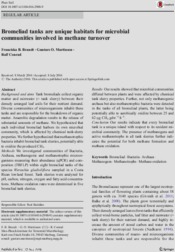| dc.contributor.author | Brandt, Franziska B. | |
| dc.contributor.author | Martinson, Guntars O. | |
| dc.contributor.author | Conrad, Ralf | |
| dc.date.accessioned | 2016-10-26T07:29:48Z | |
| dc.date.available | 2016-10-26T07:29:48Z | |
| dc.date.issued | 2016-07-23 | |
| dc.identifier.citation | Brandt, F.B., Martinson, G.O. & Conrad, R. Plant Soil (2016). doi:10.1007/s11104-016-2988-9 | |
| dc.identifier.uri | http://hdl.handle.net/11858/00-1735-0000-002B-FD0B-D | |
| dc.description.abstract | The results indicate that every bromeliad tank is a unique island with respect to its resident microbial community. The presence of methanogens and active methanotrophs in all tank slurries further indicates the potential for both methane formation and methane oxidation. | |
| dc.description.sponsorship | Max Planck Gesellschaft; LOEWE (Synmicro) Programm der hessischen Landesregierung zur Entwicklung wissenschaftlicher-ökonomischer Exzellenz | |
| dc.language.iso | eng | |
| dc.publisher | Springer Verlag | |
| dc.relation.ispartof | Plant and Soil;online first | |
| dc.subject.ddc | 631.4 | |
| dc.subject.gok | VOB 000 | |
| dc.title | Bromeliad tanks are unique habitats for microbial communities involved in methane turnover | |
| dc.type | article | |
| dc.subject.gokverbal | Bodenökologie | |
| dc.identifier.doi | 10.23689/fidgeo-2005 | |
| dc.type.version | publishedVersion | |
| dc.rights.holder | Brandt, Franziska B.; Martinson, Guntars O.; Conrad, Ralf | |
| dc.relation.issn | 1573-5036 | |
| dc.subject.free | Bromeliad | |
| dc.subject.free | Bacteria | |
| dc.subject.free | Archaea | |
| dc.subject.free | Methanogens | |
| dc.subject.free | Methanotrophs | |
| dc.subject.free | Methane oxidation | |
| dc.description.type | research | |
| dc.identifier.otherdoi | 10.1007/s11104-016-2988-9 | |


